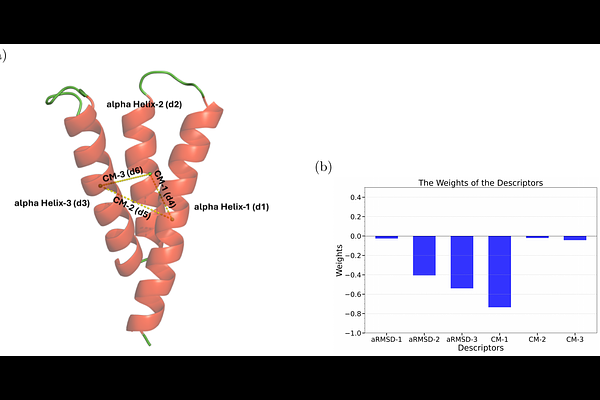Destabilization of Helix III Initiates Early Serum Amyloid A Misfolding by Exposing Its Amyloidogenic Core

Destabilization of Helix III Initiates Early Serum Amyloid A Misfolding by Exposing Its Amyloidogenic Core
Nadwa, H.; Brotzakis, Z. F.; Santucci, A.; Braconi, D.; Vendruscolo, M.
AbstractSerum amyloid A (SAA) is the principal precursor of AA amyloidosis, yet the early molecular steps that trigger its pathological misfolding remain unclear. Here, we combine high-temperature molecular dynamics simulations, harmonic linear discriminant analysis (HLDA), and parallel-tempering metadynamics (PT-MetaD) to dissect the earliest conformational transitions of the disease-relevant SAA1-76 fragment. By constructing an optimized one-dimensional collective variable (sHLDA) from inter-helix contacts and helical root-mean-square deviations, we perform nearly 4 s of enhanced sampling across 79 replicas (300-450 K). Free-energy surfaces projected onto sHLDA and radius of gyration reveal a possible misfolding trajectory comprising thirteen metastable intermediates. We identify that helix III destabilizes first, preceding loss of helix II and helix I, while global compactness is retained. This stepwise mechanism underscores the key role of helix III in the establishment of the native fold of SAA. Solvent-accessible surface-area analyses pinpoint a transient surge in exposure of the aggregation-prone core (residues 42-48) within specific misfolded intermediates, implicating localized core exposure rather than wholesale unfolding as the trigger for misfolding. Temperature-dependent secondary-structure profiling further confirms that SAA1-76 behaves as a folded bundle with disordered loops, rather than a fully disordered protein. These insights identify helix III stabilization and masking of the amyloidogenic segment as strategic avenues for therapeutic intervention.